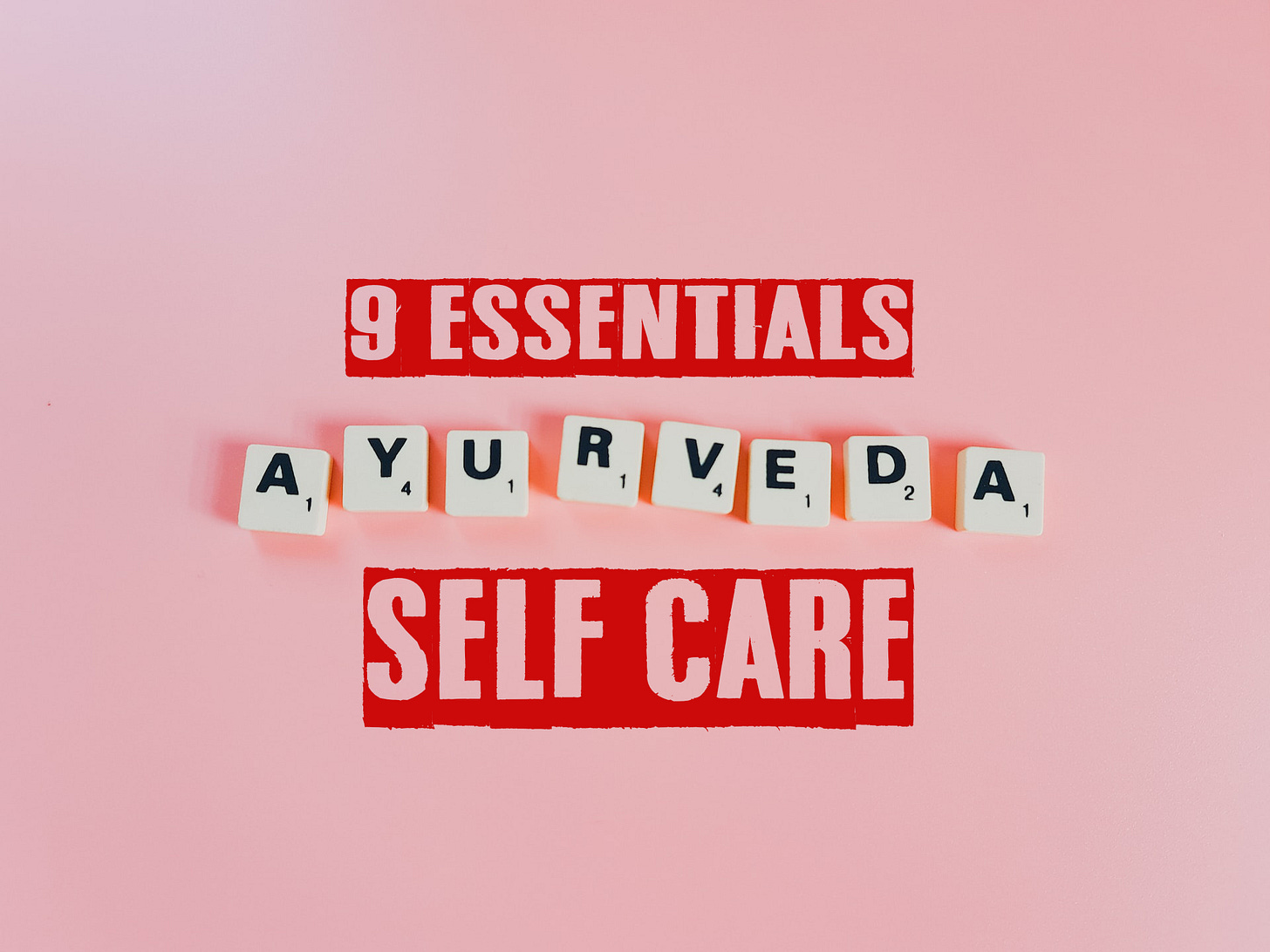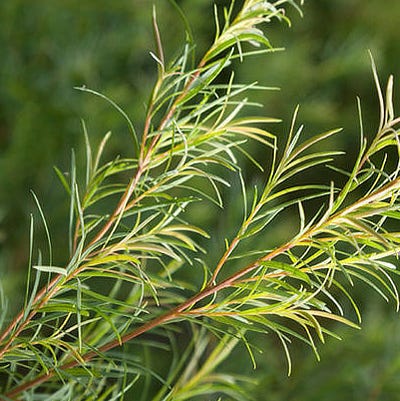9 Self-Care Essentials from Ayurveda
tea tree oil, castor oil, frankincense, vetiver, honey, ginger, turmeric, amalaki, aloe
Ayurveda, the naturopathic tradition from India, offers us a wealth of self-care wisdom. People lucky enough to be born into families that practice Ayurveda learn these self-care lifeways from an early age. But if you haven’t, it's never too late to start learning and implementing.
When to self-care?
The disease process as described by Ayurveda is called “samprapti." Samprapti charts the growth of disturbance in the body from minor excess (accumulation) to the destruction of tissues.
For instance, if you overeat, you will experience heaviness, fatigue, and perhaps a cloudy mind. The self-care solution is simple: eat lighter. The imbalance will correct in a short time.
However, if you habitually overeat foods that are too heavy for you to properly digest, kapha dosha will begin to rise (accumulate). You can still correct this yourself by consistently eating lighter and moving more.
But if you persist, kapha dosha will overflow its boundaries, spread, and take root where it is not supposed to be. In extreme cases, the destruction of tissues can result. These stages of imbalance require professional help.
The good news is that you can correct the first half of the dis-ease process using the self-care wisdom of Ayurveda. Here are some traditional medicine cabinet essentials to get you started.
Tea tree oil - Kayaputi
Tea tree oil has magical anti-bacterial properties and is your go-to for clearing minor infections of the skin, nails, and gums. It can also be rubbed into sore muscles for pain relief.
Test first and make sure that you do not have an adverse reaction. Tea tree oil is generally safe, but it is very strong.
Castor oil - Eranda
Castor oil is another magical gift from Ma Nature. You can take small amounts internally to relieve constipation.
Start with a half teaspoon in the evening before bed, and never take more than 2-3 teaspoons internally. Castor oil is powerful!
Castor oil penetrates deep into the tissues. Apply it externally to joints and areas of your body affected by inflammation in cases of sciatica, back pain, and arthritis.
Use a castor oil pack (available at pharmacies or online). Gently warm the oil, spread some onto the pack, and apply to the affected area. Cover with a towel or warm heating pad, and leave on for at least a half hour. Repeat as needed.
The most magical action of castor oil might be that of dissolving lumps and moving stagnancy. If you have a cyst or lipoma, you can gently warm the castor oil and make a pack using a large bandaid, a piece of felt, or thick muslin.
If the lump is small, use a large bandaid. Smear the pad with castor oil and leave it on all day and night. The lump will dissolve more quickly.
Castor oil packs can relieve menstrual cramps and help the blood to flow more freely. Apply a pack to the lower abdomen in the area of the uterous.
Castor oil can be rubbed into styes. You can also put a drop or two of castor oil directly into your eye to treat conjunctivitis.
Castor oil should never be used if you are pregnant because of its dissolving and downward moving actions.
Frankincense - Boswellia
Frankincense is a tree resin. Both its powdered and essential oil forms rival NSAIDS for pain relief.
Capsules of powdered resin can be taken instead of NSAIDS for any type of pain relief, but especially pain involving inflammation. Frankincense oil can also be rubbed directly on the area of the body where pain is occurring.
Use frankincense for clearing mind channels when you are experiencing lack of clarity, confusion, depression, or brain fog. Apply a dab of frankincense oil to the temples, third eye, and crown of the head.
Frankincense should not be taken internally if pregnant. If the digestive system is weak and Pitta is predominant in your constitution, you may experience digestive upset when taking powdered frankincense. Start with a very low dose and proceed with caution.
Vetiver oil - Khus
Vetiver grass produces an essential oil that is both cooling and grounding. It can be used as a scent externally on the skin during the summer months for cooling off and during fall for grounding when Vata is on the rise.
During the summer, dab vetiver oil on the insides of the wrists. In the fall, mix a few drops of vetiver with sesame oil and massage into the bottoms of the feet. Put on wool socks and experience a more restorative sleep.
Ayurveda outlines many internal uses for preparations of dried vetiver powder (ushira). However, these preparations should only be used under the supervision of an Ayurvedic clinician.
Honey
Honey has many uses in nearly every form of traditional medicine. It might just be the most magical substance on planet Earth!
Honey is warming, astringent, and strongly anti-bacterial.
Internally, use raw, local honey mixed with lukewarm water to clear mucus from the throat and lungs and soothe a cough. For a stronger congestion-clearing preparation, mix raw honey with ground pippali (long pepper) and powdered or fresh-grated ginger.
Weak lungs can be supported long-term with a mixture of a teaspoon of honey and a large pinch of ground long pepper (pippali) up to 2x per day.
If you suffer from seasonal allergies, eating a teaspoon of raw local honey daily just before and during allergy season can greatly reduce your symptoms.
Ginger
Ginger is heating. Raw ginger is less heating overall and more peripherally heating than dry, ground ginger. Young ginger is gently warming and safest for pitta predominant constitutions if you can find it. Dry ginger is sharper and more centrally heating than raw ginger.
Use a small amount of dry ginger in warm water for moving the bowels first thing in the morning. Trikatu is a widely-available mixture of dry ginger, black pepper, and long pepper that increases digestive fire. Fresh ginger is great for moving blood to the fingers and toes and driving out cold.
Drink cinnamon, lemongrass, and fresh ginger tea when you have a cold to induce sweating and open the channels.
Do not use ginger with high pitta symptoms such as irritation, chronic anger, heartburn or ulcers or any inflammatory intestinal condition.
Turmeric - Haridra/Haldi
Turmeric’s strong anti-inflammatory properties make it a natural alternative to NSAIDS. Curcumin, a turmeric extract, is now often found alone or in nutraceutical formulas that help to relieve the pain of fibromyalgia, osteoarthritis, and other joint and muscle pains.
A few drops of turmeric essential oil can be added to a carrier oil along with other essential oils as a DIY face serum.
Both turmeric and curcumin can be heating to those with a pitta constitution, so use with caution and see how much you can tolerate. People who are prone to migraine should also use caution when experimenting with turmeric.
Turmeric strongly stimulates the release of bile and movement in the gallbladder. So it is great for sluggish digestion. But if you have been diagnosed with gallstones, you need to be extremely cautious when using concentrated forms of turmeric or downing turmeric powder in capsule form.
Turmeric is safest when used in recipes of cooked foods. While the Western nutraceutical industry and naturopaths say that turmeric in its native form is not strong enough, over time a more gentle approach can have many protective benefits.
Indian gooseberry - Amalaki
Amalaki is a fruit and a general rejuvenative tonic for good health and immunity. It is rejuvenative for most systems in the body including the reproductive system, digestion, and the heart and blood. Many Indian people who follow the tradition of Ayurveda eat a daily amalaki fruit right off of the tree. You can find it in capsules or as a loose powder from any seller of Ayurvedic herbs. It’s also high in vitamin C.
Aloe vera - Kumari
Aloe vera’s energy is strongly cooling. The juice and gel are used topically to relieve sunburn and soothe other inflammations.
Aloe can be a useful partner in healing damage to the skin and mucus membranes, including wounds, eczema, and mouth ulcers.
Taken internally, aloe vera can counteract hyperacidity and excess pitta in general.
Drinking aloe juice is particularly soothing and hydrating for heat and dryness in the female reproductive system during perimenopause and menopause.
Some self-care advisements
Make a lifetime study of any naturopathic tradition that you decide to use. Be humble and go slowly, but steadily. Ask for help when you need it. There are some good beginning Ayurveda learning and reference works listed at the bottom of this article.
Know your limits. Do not attempt to treat serious illness on your own. Be honest with yourself and recognize when you need professional help.
When taking any herb or spice internally, try to find an organic version.
Start with a lower than suggested dose and see how you react. The Western nutraceutical industry’s tendancy to push megadoses and quick cures is not usually the best course. A better approach is to use self-care medicinals to gently move your system into more balance, encouraging the body and mind’s own healing powers to assert themselves.
Learning resources
Ayurveda: A Practical Guide: The Science of Self-Healing by Dr. Vasant Lad
Not quite ready to fire up a paid subscription, but want to show your appreciation?
Please join Shambhavi and the Jaya Kula community for satsang & kirtan every Sunday at 3:00pm Pacific. Come in person to 1215 SE 8th Ave, Portland, OR, or join Jaya Kula’s newsletter to get the Zoom link for satsang. You can also listen to my podcast—Satsang with Shambhavi—wherever podcasts are found.














Thank you for this info, Shambavi!